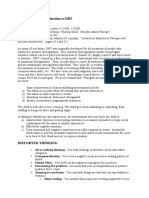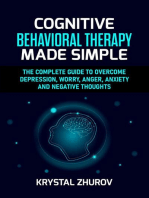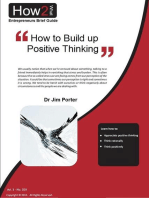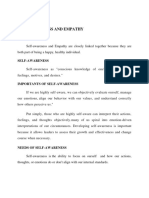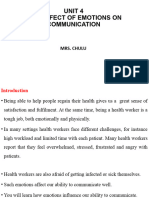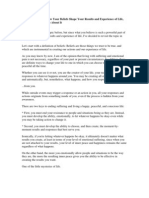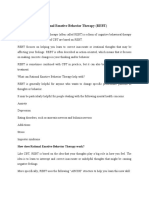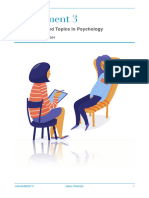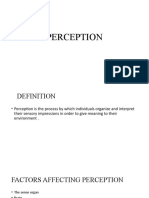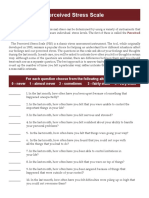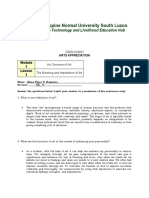0 ratings0% found this document useful (0 votes)
36 viewsCognitive Behavior Therapy
Cognitive Behavior Therapy
Uploaded by
aqsaCognitive behavior therapy uses cognitive behavior modification procedures to help people change cognitive behaviors, or thoughts, that are distressing. The first step is to define the cognitive behavior precisely. Cognitive restructuring procedures help identify distressing thoughts and replace them with more rational thoughts. Variations include cognitive therapy, rational emotive therapy, and systematic rational restructuring. Cognitive therapy for depression involves identifying distorted thinking and replacing it with more accurate thoughts. Cognitive coping skills training teaches clients self-statements to use in problem situations.
Copyright:
© All Rights Reserved
Available Formats
Download as PPTX, PDF, TXT or read online from Scribd
Cognitive Behavior Therapy
Cognitive Behavior Therapy
Uploaded by
aqsa0 ratings0% found this document useful (0 votes)
36 views57 pagesCognitive behavior therapy uses cognitive behavior modification procedures to help people change cognitive behaviors, or thoughts, that are distressing. The first step is to define the cognitive behavior precisely. Cognitive restructuring procedures help identify distressing thoughts and replace them with more rational thoughts. Variations include cognitive therapy, rational emotive therapy, and systematic rational restructuring. Cognitive therapy for depression involves identifying distorted thinking and replacing it with more accurate thoughts. Cognitive coping skills training teaches clients self-statements to use in problem situations.
Original Description:
Cognitive behavioural therapy
Original Title
CBT
Copyright
© © All Rights Reserved
Available Formats
PPTX, PDF, TXT or read online from Scribd
Share this document
Did you find this document useful?
Is this content inappropriate?
Cognitive behavior therapy uses cognitive behavior modification procedures to help people change cognitive behaviors, or thoughts, that are distressing. The first step is to define the cognitive behavior precisely. Cognitive restructuring procedures help identify distressing thoughts and replace them with more rational thoughts. Variations include cognitive therapy, rational emotive therapy, and systematic rational restructuring. Cognitive therapy for depression involves identifying distorted thinking and replacing it with more accurate thoughts. Cognitive coping skills training teaches clients self-statements to use in problem situations.
Copyright:
© All Rights Reserved
Available Formats
Download as PPTX, PDF, TXT or read online from Scribd
Download as pptx, pdf, or txt
0 ratings0% found this document useful (0 votes)
36 views57 pagesCognitive Behavior Therapy
Cognitive Behavior Therapy
Uploaded by
aqsaCognitive behavior therapy uses cognitive behavior modification procedures to help people change cognitive behaviors, or thoughts, that are distressing. The first step is to define the cognitive behavior precisely. Cognitive restructuring procedures help identify distressing thoughts and replace them with more rational thoughts. Variations include cognitive therapy, rational emotive therapy, and systematic rational restructuring. Cognitive therapy for depression involves identifying distorted thinking and replacing it with more accurate thoughts. Cognitive coping skills training teaches clients self-statements to use in problem situations.
Copyright:
© All Rights Reserved
Available Formats
Download as PPTX, PDF, TXT or read online from Scribd
Download as pptx, pdf, or txt
You are on page 1of 57
Cognitive Behavior Therapy
Cognitive Behavior Modification
Cognitive behavior modification procedures are
used to help people change behaviors that are
labeled as cognitive. Before describing cognitive
behavior modification procedures, it is
important to provide a behavioral definition of
cognitive behavior.
Defining Cognitive Behavior
When behavior modification procedures are used to change a target
behavior, the target behavior must be identified and defined in
objective terms so that its occurrence can be recorded. This is true
for overt behaviors, as well as covert behaviors such as cognitive
behaviors. You can’t change a target behavior unless you know
exactly what the behavior is and when it is occurring. For overt
behaviors, this involves direct observation and recording of the
behavior by an independent observer or by the person exhibiting the
target behavior (self-monitoring). Because cognitive behaviors are
covert, they cannot be observed directly and recorded by an
independent observer. Rather, the person engaging in the cognitive
behavior must identify and record the occurrence of the behavior.
Cognitive Behavior Modification Procedures
Cognitive Restructuring
In cognitive restructuring procedures, the therapist helps the client identify
cognitive behaviors that are distressing and then helps the client get rid of
these distressing thoughts or replace them with more desirable thoughts.
Distressing thoughts might be those that elicit emotional responses such as
fear, anxiety, or anger, or those that are associated with unpleasant moods,
problem behaviors, or poor performance.
• Cognitive restructuring consists of three basic steps.
1. Helping the client identify the distressing thoughts and the situations in
which they occur.
2. Helping the client identify the emotional response, unpleasant mood, or
problem behavior that follows the distressing thought.
3. Helping the client stop thinking the distressing thoughts by helping the
client think more rational or desirable thoughts.
Types of cognitive restructuring
Variations of cognitive restructuring. These
variations include
• Cognitive therapy
• Rational-emotive therapy,
• Systematic rational restructuring, and
Cognitive therapy
Cognitive therapy for depression involves first getting the person to engage in
more reinforcing activities. The next step is to use cognitive restructuring to
help the person change his or her distorted thinking. When the person
engages in more reinforcing activities and replaces the distorted self-talk with
more rational or accurate self-talk, the person is less likely to report that he or
she is depressed.
After identifying the distorted thinking that a person engages in, the next step
is to challenge the person to evaluate his or her thoughts and replace the
distorted thinking with more accurate or logical thoughts. You challenge a
person’s distorted thinking by asking three types of questions.
■ Where is the evidence?
■ Are there any alternative explanations?
■ What are the implications?
Cognitive behavior therapy
Cognitive Coping Skills Training
In cognitive coping skills training, the therapist teaches clients specific self-
statements that they can make in a problem situation to improve their
performance or influence their behavior in the situation
Self-Instructional Training
Self-instructional training consists of three basic steps.
1. Identify the problem situation and define the desirable behavior most
appropriate to the situation.
2. Identify the self-instructions that will be most helpful in the problem
situation.
3. Use behavioral skills training to teach the self-instructions. (in role plays)
Step by step CBT in action
Linking thinking and feeling
Attaching meaning to events Positive events normally lead to positive
emotions and negative events to negative emotions (rather obviously). But
the personal meanings you assign to events in your life sometimes may lead
to unhealthy and problematic emotional reactions. Sometimes your thinking
can lead you to attach extreme meanings to relatively minor events
When you attach a faulty meaning to an event, you’re very likely to
experience an unhealthy negative emotion, such as extreme guilt as Coral
does in the following example. However when Coral attaches a fair and
accurate meaning to the event, she experiences the healthy negative
emotion of intense disappointment. We also use the words distressed and
disturbed to refer to healthy and unhealthy negative emotions. The
difference between distress and disturbance is in the quality of the emotion
you experience.
• ✓ Disturbed refers to inaccurate or rigid ways
of thinking about events that lead you to
experience extreme unhealthy negative
emotions.
• ✓ Distressed refers to accurate and balanced
ways of thinking about events that lead you to
experience appropriate healthy negative
emotions.
Ranking your problems
• Sometimes problems don’t fall into neat and
tidy categories or they overlap somewhat. You
can use the Problem Clarification
• Consider what problems you have and how
they impact on different areas of your life.
Work, home life, relationships, physical health
and study are some areas your problems may
impact. Review your list and look for any
overlapping symptoms.
Pie chart
for
problem
ranking
out of 100
Breaking down your behaviours
• Disturbed emotions tend to lead to destructive
and self-destructive behaviours.
• Destructive behaviour rarely aids effective
problem solving. On the contrary, it often
• creates further problems or worsens existing
ones. Worksheet 1-7 is yet another
• checklist to help you to identify different types
of big, bad, and ugly behaviours that
• you may sometimes recognise yourself doing.
Connecting Emotion, Thinking,
and Behaviour (Picturing Your Problems as a Simple A-B-C)
Recognising Problematic
Thinking Patterns
• Catastrophising is
when you take a
relatively minor event
and imagine all sorts
of terrors and
nightmare scenarios
resulting from it.
Another way of
describing this thinking
error is ‘making a
mountain out of a
molehill’.
• All or nothing
thinking – also
called ‘black or
white’ thinking –
involves assuming
that a situation is
either entirely good
or entirely bad,
leaving no in-
between or grey
areas.
Fortune-telling: With
fortune-telling you
make predictions
about the future and
firmly believe that your
prophetic visions are
correct. The trouble is
that many of your
predictions are likely to
be negative and may
stop you from taking
goal-directed action.
• Mind reading: you
often assume that
others are thinking
in judgemental and
disapproving ways
about you. These
assumptions can
lead to all sorts of
difficulties such as
social anxiety and
relationship
ruptures.
• Emotional reasoning is
when you decide that
your strong feelings
are a true reflection of
what is actually going
on in reality. Because
you feel a certain way
you decide that your
feelings must be
correct. You may then
fail to take in other
information that
contradicts your
feelings.
• Over-generalising and
making widespread
judgements about
yourself, others, or the
world on the strength of
one or two particular
features. This tendency
is also called making the
part/hole error; that is,
you judge the whole on
the basis of one or
more of its parts. Doing
so can lead you to make
some pretty rash and
harsh judgements and
to hold a pretty
unforgiving attitude.
• Labeling and rating–
and it’s an ugly place
to be. If you call
yourself ‘useless’
every time you screw
up, or the world
‘cruel’ every time it
deals you a blow, or
others ‘no good’
when you’re treated
impolitely, then
you’re in danger of
feeling a lot of really
toxic emotions.
• Mental filtering you
only let information
through that fits with
what you already
believe about
yourself, others, or
the world. So if you
think of yourself as a
failure you only
process information
that points to you
failing
• Disqualifying the
positive is very similar
to mental filtering.
Imagine, for example,
that you believe that
you are unlikable and
unacceptable socially.
Your mental filter only
lets you notice
information that
supports your
negative self opinion.
If any positive
information does
sneak through your
filter, you quickly
discredit or disqualify
it and throw it back
out.
• Having low frustration
tolerance (LTF) is
about deciding that
uncomfortable equals
unbearable. Basically,
if you have LFT you’re
likely to give up
striving toward your
goals whenever the
going gets too tough
or painful.
• Personalising involves
taking random events
and making them a
personal issue. You
tend to make
everything that
happens around you
about you, even if
reality indicates
otherwise. This
tendency can lead you
to assume
inappropriate
responsibility for
events and/or to feel
unhealthy emotions in
response to events that
have little or nothing to
do with you.
Noticing Your Negative Thinking
• Negative automatic thoughts, or NATs for short, are thoughts that seem to
just pop into your head without warning or welcome. That’s why we refer to
these thoughts as automatic. Frequently, NATs are extreme, distorted, and
unhelpful ways of interpreting an event or situation, which is why we refer to
them as negative.
• Noticing your NATs can increase your chances of managing your emotions by
allowing you to correct any unhelpful thoughts you may be having about an
event. NATs are shortened versions of your beliefs and noticing them more
readily helps you better understand how your beliefs are leading to specific
emotions about a given situation. The A-B-C Form helps you to change
unhelpful beliefs and NATs in order to overcome your emotional problems.
• According to CBT, an event doesn’t directly or solely cause you to experience
an emotion. Rather, the meaning that you assign to the event (your thoughts,
beliefs, and att
• Use the cognition
correction quiz in
Worksheet as many
times as you need to
until you have
challenged all your
unhelpful thoughts
related to your trigger.
Aiming Your Attention
Particularly if you suffer
from anxiety or depression,
you’re likely to have a lot of
threatening or pessimistic
thoughts (or both). Not a
lot of fun. Harnessing the
ability to not pay attention
to your thoughts can be
very useful in these
circumstances.
Concentrating on anxious
or depressed thinking can
further lower your mood or
heighten your anxiety. With
practice you can learn to
dis-attend to your thinking
and focus your attention on
the outside world instead.
Training Yourself in Task Concentration
The purpose of task concentration exercises is to help you get
better at choosing what you concentrate on rather than allowing
your attention to wander. Everyone has the ability to focus their
attention and to concentrate on a task whilst filtering out
extraneous stimuli. Some people are better at doing this than
others, possibly as a result of practice.
It’s generally easier to dis-attend from unhelpful thoughts in
situations where you’re pretty comfortable than in those that
provoke anxiety or low mood. By listing both threatening and non-
threatening situations, you can practise deliberately directing your
attention where you want it to go in situations where you feel okay
and eventually do the same in less comfortable situations.
Try these steps to help you get behind the steering wheel of your attention:
1. Focus on your internal feelings and thoughts for a few minutes (you can time
yourself if you like). Note any unpleasant physical sensations, negative thinking
and images.
2. Now interrupt those thoughts and turn your attention to your environment and
other people. Keep your attention on the outside world for a few minutes (time
yourself if you like) and make mental notes of what you see going on around you.
3. Now switch your attention back and forth between your internal world and the
external world.
4. Try keeping your attention on the external environment for longer periods,
pulling your attention away from your internal thoughts and feelings should it
wander.
5. After you’ve gotten used to turning your attention to what you decide to focus
on- try doing the same in situations you typically find threatening.
6. Work your way through your threatening situations starting from the easiest to
the hardest
• Using a simple pie
chart is another
quick and effective
way of monitoring
the focus of your
attention and
recording how you
divided your
attention or
concentration in a
given situation.
CBT and Emotions
CBT therapists make a distinction between two types of
negative feeling states or emotions – healthy and
unhealthy.
Healthy emotions are those feelings you have in response
to negative events that are appropriate to the event, lead
to constructive action, and don’t significantly interfere
with the rest of your life.
Unhealthy emotions are feelings you have that are out of
proportion to the event in question, tend to lead to self-
destructive behaviours, and cause problems in other areas
of your life.
Expanding Your Emotional Vocabulary
• The advantages of applying a specific label or name
to your feelings are threefold:
✓ It is easier for others (and even for yourself) to
understand the precise nature of what you’re feeling.
✓ It makes it easier for you to work out whether what
you’re feeling is a healthy or unhealthy negative
emotion.
✓ It becomes easier for you to select an alternative
healthy negative emotion as a goal.
• ✓ Anger
• ✓ Anxiety
• ✓ Concern
• ✓ Depression
• ✓ Disappointment
• ✓ Embarrassment
• ✓ Envy
• ✓ Fear
• ✓ Grief
• ✓ Guilt
• ✓ Hurt
• ✓ Jealousy
• ✓ Regret
• ✓ Remorse
• ✓ Sadness
• ✓ Shame
Make client
Understand the
Anatomy of Emotions
• All human emotions –
whether positive or
negative, healthy or
unhealthy – are
comprised of four
dimensions. These
dimensions interact
and reinforce one
another.
Working Out Whether Your Feelings
Are Healthy or Unhealthy
As you may already realise, your thoughts, attention, focus, behaviour, and even some
of your physical sensations are ways of determining whether you’re in the grip of an
unhealthy or a healthy emotional experience. These four aspects or dimensions of
emotional experience are different depending on the type of feeling you’re having.
For example, the action tendencies associated with healthy sadness tend to be
constructive. They help you to accept and adjust to a negative event or situation.
The action tendencies associated with unhealthy depression tend to be destructive
because they prevent you from accepting the negative event and moving forward. In
general, healthy negative emotions are less intensely uncomfortable than their
unhealthy counterparts.
Even if you’re extremely sad you’re likely to feel less intense discomfort or emotional
pain than if you’re unhealthily depressed.
Connection of behavior with healthy and
unhealthy tendencies
Avoiding being fooled by physical feelings
Many (most) emotions, both healthy and
unhealthy, are accompanied by physical
sensations or symptoms. As a general rule, the
symptoms you have when you’re feeling healthy
distress aren’t as uncomfortable or debilitating
as those associated with unhealthy disturbance.
Physical symptoms of healthy distress also tend
to reduce or disappear more quickly.
CBT and Anxiety
You might also like
- DIR Session NotesDocument2 pagesDIR Session Notescirclestretch100% (2)
- Gestalt Principles 2022 HandoutDocument14 pagesGestalt Principles 2022 HandoutAkshaykumar WaddarkallNo ratings yet
- Beck's Cognitive TheoryDocument14 pagesBeck's Cognitive TheoryFatima Asim 922-FSS/BSPSY/F17No ratings yet
- Self-Esteem - A Self Help GuideDocument10 pagesSelf-Esteem - A Self Help Guideiosivp60% (5)
- DBT - Rad S BorderlineomDocument34 pagesDBT - Rad S BorderlineomMArkoNo ratings yet
- Improving Self-Esteem Module 4 of 9Document13 pagesImproving Self-Esteem Module 4 of 9valeria_kendall6388100% (1)
- Life Skills Unit 2Document11 pagesLife Skills Unit 2Morning-Star AnwarNo ratings yet
- 15 Common Cognitive Distortions - Mind My PeelingsDocument30 pages15 Common Cognitive Distortions - Mind My PeelingsSamrandNo ratings yet
- The Cognitive-Behavioral ApproachDocument19 pagesThe Cognitive-Behavioral ApproachTejas DangodraNo ratings yet
- Cognative Behavioural TherapyDocument6 pagesCognative Behavioural TherapyAshani Aarora100% (1)
- Who Controls You? How Rational Emotive & Cognitive Behaviour Therapy Can Help You Change Unwanted Emotions & BehavioursDocument14 pagesWho Controls You? How Rational Emotive & Cognitive Behaviour Therapy Can Help You Change Unwanted Emotions & BehavioursRebecca Lee Foong Sim100% (2)
- Cognitive Behavioral Therapy Made Simple: The Complete Guide to Overcome Depression, Worry, Anger, Anxiety and Negative ThoughtsFrom EverandCognitive Behavioral Therapy Made Simple: The Complete Guide to Overcome Depression, Worry, Anger, Anxiety and Negative ThoughtsNo ratings yet
- Managing Negative or Unhelpful Thoughts: So How Do Thoughts Work?Document5 pagesManaging Negative or Unhelpful Thoughts: So How Do Thoughts Work?Adrienn Krisztina VargaNo ratings yet
- The No BS Guide To Organizing Your FeelingsDocument6 pagesThe No BS Guide To Organizing Your FeelingsMae Gamz100% (2)
- Cognitive ErrorsDocument29 pagesCognitive ErrorsTIWARI priyanshuNo ratings yet
- Cognitive Behavioural TherapyDocument9 pagesCognitive Behavioural TherapyBhAVya 27No ratings yet
- CBTDocument7 pagesCBTigodspower773No ratings yet
- Who Controls YouDocument8 pagesWho Controls YouMaritsa Engelbrecht100% (3)
- 25 CBTDocument6 pages25 CBTMihaela VădeanuNo ratings yet
- Negative Thinking: How To Transform Negative Thoughts And Self Talk Into Positive ThinkingFrom EverandNegative Thinking: How To Transform Negative Thoughts And Self Talk Into Positive ThinkingNo ratings yet
- Gain Control of Your EmotionsDocument18 pagesGain Control of Your EmotionsAfzal Akthar100% (1)
- Mini ProDocument43 pagesMini ProsarathyNo ratings yet
- Attitude Is Everything PDFDocument13 pagesAttitude Is Everything PDFsharief145No ratings yet
- Thinking DistortionsDocument22 pagesThinking Distortionsinter levelNo ratings yet
- ApriloneDocument2 pagesAprilonemisoo.me3No ratings yet
- Proven Methods Techniques For Handling Emotions - Key TakeawaysDocument4 pagesProven Methods Techniques For Handling Emotions - Key TakeawaysDnyaneshwar Desai100% (1)
- The Cognitive ModelDocument3 pagesThe Cognitive ModelMuhammad Ahmad NaeemNo ratings yet
- Feeling GoodDocument8 pagesFeeling GoodindulekharoldantzNo ratings yet
- EFFECTS OF EMOTIONS ON COMMUNICATIONpptDocument41 pagesEFFECTS OF EMOTIONS ON COMMUNICATIONpptabrahammwansa2No ratings yet
- Cognitive Behaviour Therapy CBT: BY Dr. Anitha AreDocument20 pagesCognitive Behaviour Therapy CBT: BY Dr. Anitha AreVishal MauryaNo ratings yet
- How To Reframe Self Critical Thoughts and Boost Your Self-EsteemDocument36 pagesHow To Reframe Self Critical Thoughts and Boost Your Self-EsteemMark DessauerNo ratings yet
- Beliefs Shape RealityDocument8 pagesBeliefs Shape Realitydeepak2628100% (1)
- Cognitive RestructuringDocument5 pagesCognitive RestructuringTuba JadoonNo ratings yet
- REBTDocument7 pagesREBTLearn Earn onlineNo ratings yet
- Rational Emotive Behavior TherapyDocument9 pagesRational Emotive Behavior Therapycoun sellorNo ratings yet
- Effective Ways To Increase Self AwarenessDocument13 pagesEffective Ways To Increase Self AwarenessDipmalya Sarkar100% (1)
- Lecture 10 Cognitive TherapyDocument22 pagesLecture 10 Cognitive TherapySyed Anis u RahmanNo ratings yet
- Summary of Calvin Caufield's Acceptance and Commitment Therapy ToolboxFrom EverandSummary of Calvin Caufield's Acceptance and Commitment Therapy ToolboxNo ratings yet
- Cognitive DistortionsDocument9 pagesCognitive DistortionsRenato de MoraisNo ratings yet
- Notes For Further Reading and Mastery of CBT: PsychoanalysisDocument29 pagesNotes For Further Reading and Mastery of CBT: PsychoanalysisPsyNo ratings yet
- Cognitive Behavior TherapyDocument27 pagesCognitive Behavior TherapyAlexander GarciaNo ratings yet
- Cognitive DistortionsDocument5 pagesCognitive Distortionsfrozenflameboy100% (1)
- 2017CS10324 Ass3Document9 pages2017CS10324 Ass3Amal PrasadNo ratings yet
- How To Become Emotionally StableDocument5 pagesHow To Become Emotionally StableIvana Vujić100% (1)
- Eliminate Negative Thoughts With Secret Tricks Bringing Peace And Happiness Into Your LifeFrom EverandEliminate Negative Thoughts With Secret Tricks Bringing Peace And Happiness Into Your LifeNo ratings yet
- Coping With The DisorderDocument5 pagesCoping With The Disordermi410100% (1)
- CBT Power PointDocument42 pagesCBT Power PointmasonssecretlabNo ratings yet
- SUMMARY Of Think Like A Monk: Train Your Mind For Peace And Purpose Every DayFrom EverandSUMMARY Of Think Like A Monk: Train Your Mind For Peace And Purpose Every DayNo ratings yet
- What Is Reality Testing and Why Is It ImportantDocument5 pagesWhat Is Reality Testing and Why Is It ImportantGeo HadNo ratings yet
- Selected Topic in Clinical Psy FinalDocument23 pagesSelected Topic in Clinical Psy FinalSümeyye KüçükaliNo ratings yet
- Mind Your Mood - Proven Steps to Control Your Mood SwingsFrom EverandMind Your Mood - Proven Steps to Control Your Mood SwingsRating: 5 out of 5 stars5/5 (1)
- Cognitive Behavioral Therapy: How To Eliminate Addiction TriggersFrom EverandCognitive Behavioral Therapy: How To Eliminate Addiction TriggersNo ratings yet
- How To Not Take Things PersonallyDocument4 pagesHow To Not Take Things PersonallyNadeem Iqbal100% (1)
- Correcting Distorted ThinkingDocument7 pagesCorrecting Distorted ThinkingYungston100% (3)
- Cognitive Therapy FinalDocument14 pagesCognitive Therapy FinalEbraheem NegmNo ratings yet
- A To C ThinkingDocument9 pagesA To C ThinkingMian UmarNo ratings yet
- (E1) Thoughts-Create-Emotions-And-StuffDocument6 pages(E1) Thoughts-Create-Emotions-And-StuffjujuNo ratings yet
- 7 Steps to Think Positive: Achieve Success Through a Positive MindsetFrom Everand7 Steps to Think Positive: Achieve Success Through a Positive MindsetNo ratings yet
- Week 02 Quarter 01Document7 pagesWeek 02 Quarter 01Dodalyn MananganNo ratings yet
- Errors in ThinkingDocument17 pagesErrors in ThinkingSharoz ShahNo ratings yet
- Feeling and Emotions Fun Activities Games 13783Document3 pagesFeeling and Emotions Fun Activities Games 13783evt1203No ratings yet
- Pengaruh Gaya Pengasuhan Orang Tua Terhadap Efikasi Diri Keputusan Karir Siswa SMK Melalui Trait Kecerdasan Emosi Sebagai Variabel MediatorDocument27 pagesPengaruh Gaya Pengasuhan Orang Tua Terhadap Efikasi Diri Keputusan Karir Siswa SMK Melalui Trait Kecerdasan Emosi Sebagai Variabel MediatorjokoNo ratings yet
- HappinessDocument28 pagesHappinessJang100% (1)
- Empathy Fieldguide-1 PDFDocument10 pagesEmpathy Fieldguide-1 PDFPhilosofee HijabNo ratings yet
- Meireles 1998Document9 pagesMeireles 1998Sebastián RiffoNo ratings yet
- Managing Emotions (EQ) - Dec2014)Document53 pagesManaging Emotions (EQ) - Dec2014)Aiman SabqiNo ratings yet
- Week 2 Spatial Organization PresentationDocument8 pagesWeek 2 Spatial Organization PresentationMatthewWeitzNo ratings yet
- Today I Am Free - Manifesting Through Deep Inner Changes - Richard Dotts (Dotts, Richard) - 2015 - Richard Dotts - Anna's ArchiveDocument72 pagesToday I Am Free - Manifesting Through Deep Inner Changes - Richard Dotts (Dotts, Richard) - 2015 - Richard Dotts - Anna's Archiveangie mm100% (1)
- Emotion Focused Therapy - Greenberg 2004 PDFDocument14 pagesEmotion Focused Therapy - Greenberg 2004 PDFiprates2No ratings yet
- Invisible Man Rhetorical AnalysisDocument2 pagesInvisible Man Rhetorical Analysisapi-256400148No ratings yet
- Character Motivation InteractiveDocument2 pagesCharacter Motivation Interactiveapi-293389854No ratings yet
- PerceptionDocument21 pagesPerceptionJaanu JaanuNo ratings yet
- Forgiveness EssayDocument5 pagesForgiveness Essayapi-709264383No ratings yet
- Jianwai SOHO + ZumthorDocument12 pagesJianwai SOHO + ZumthorNicholas SocratesNo ratings yet
- Burchatti English AlsDocument30 pagesBurchatti English Alsriteshrajsha2004No ratings yet
- Sensation and PerceptionDocument13 pagesSensation and PerceptionRiza Roncales100% (1)
- Managing Emotions InfographicDocument4 pagesManaging Emotions InfographicYoga Arfiansyah Firdaus100% (4)
- Chapter 10 The ActDocument8 pagesChapter 10 The Actmaye labitoriaNo ratings yet
- Dissecting Our Human ExperienceDocument3 pagesDissecting Our Human ExperienceDorNo ratings yet
- What Is ForgivenessDocument3 pagesWhat Is ForgivenessRemy BedañaNo ratings yet
- Motivation and Emotion HandoutsDocument7 pagesMotivation and Emotion Handoutsallen2912No ratings yet
- Lesson 9 Coping With StressDocument46 pagesLesson 9 Coping With StressAlfredo ModestoNo ratings yet
- You Are Already EnoughDocument17 pagesYou Are Already Enoughmarkjames.castilloNo ratings yet
- Percieved Stress Scale PDFDocument2 pagesPercieved Stress Scale PDFclara100% (1)
- Emotions and Economic Theory Jon E PDFDocument29 pagesEmotions and Economic Theory Jon E PDFAura Maria LopezNo ratings yet
- Klasifikasi Delusi (Waham) Dan HalusinasiDocument4 pagesKlasifikasi Delusi (Waham) Dan HalusinasiGinaa aaaNo ratings yet
- 2GED - HUM01 Art AppreciationDocument2 pages2GED - HUM01 Art AppreciationKhen Vince V. HeguerraNo ratings yet




